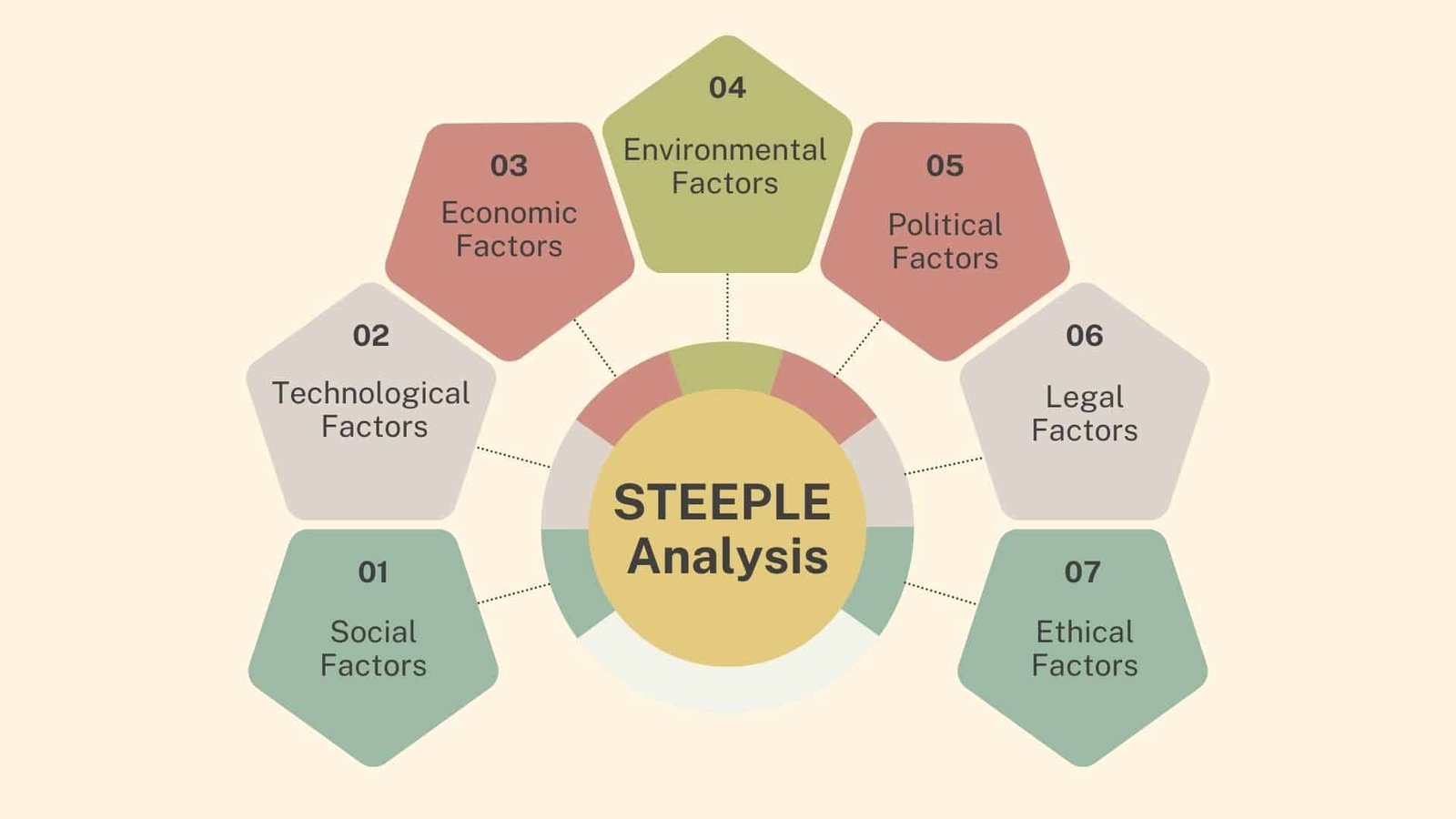In today’s fast-paced and ever-changing business environment, companies need to monitor their internal environment and examine their external surroundings. One of the most effective methods of doing this is STEEPLE Analysis. Whether you are setting up a startup, managing a business or pursuing your MBA, an understanding of this strategy will help you challenge the threats as well as grab opportunities.
Let’s take a look into what STEEPLE is, how it works and how global brands like Starbucks leverage it to embrace change.
What is STEEPLE Analysis?
STEEPLE Analysis is a strategic framework utilized by businesses to determine external macro-environmental factors at work. It stands for:
Social, Technological, Economic, Environmental, Political, Legal, and Ethical factors.
It is extended from the familiar PESTLE model by including Ethical factors—necessary aspects in today’s social conscience market.
Why Use STEEPLE Analysis?
It simply enables organizations to see through a broader lens into their environment. It helps:
- Identify external opportunities and threats
- Data-supported strategic choices
- Market trends and consumer behaviors on anticipated basis
- Practice compliance with legal and ethical norms
- Make resilient and sustainable business models
It can especially be beneficial for the introduction of new products, new market entry or long-term strategic planning.
STEEPLE Analysis Template
A template of STEEPLE Analysis is shown as an example of Starbucks Company.
Breakdown of STEEPLE Analysis (with Starbucks example)
Let us go deeper into each one of the factors with real-life application. Here is the analysis of the most successful brands “Starbucks”.
Social Factors
Local conceptions of demographics, shifting lifestyles, educations, health trends and cultural values. Starbucks fine-tunes its offerings to local tastes by introducing region-specific drinks and menu options to suit changing consumer expectations.
🟢 Example: In Asian markets, Starbucks offers Matcha-based drinks. Likewise, in health-conscious regions, it promotes plant-based milks and low-sugar options.
Business Insight: Understanding social trends helps Starbucks stay relevant and culturally connected worldwide.
Technological Factors
Technology defines how businesses are innovating and consuming goods. Starbucks implements a mobile app for ordering, payment processing, loyalty rewards and personalized offers. In addition, they utilize AI and data analytics to enhance inventory management and customer behavior forecasting.
🟢 Example: Starbucks app is a leader in mobile ordering by making it easy for customers to customize and pick up drinks.
Business Insight: Technology creates room for Starbucks to improve customer experience and operational efficiency.
Economic Factors
Inflation, incomes, exchange rates and employment are some of the economic changes that can increase or decrease consumer purchasing ability. Starbucks uses variable pricing dependent on value-for-money considerations while constantly monitoring global economic conditions in a competitive sense.
🟢 Example: Good deals on affordable beverages through bundled offers and loyalty discounts are earmarked for customers during hard economic times.
Business Insight: Starbucks depends on financial flexibility for tactical responses to competencies and loss of market share.
Environmental Factors
These days the environment is everything. Starbucks is actively reducing its carbon pollution by eliminating single-use plastics, working to promote user-friendly cups and sourcing coffee responsibly.
🟢 Example: The company is set to become resource-positive by cutting down on emissions, waste and water consumption across all its operations.
Business Insight: Starbucks’ eco-friendly approach engaged well to its consumers’ current expectations and in the long run will either add or keep up with brand value.
Political Factors
Governmental policies, trade regulations and political stability influence ways and means of pursuing business activity. Starbucks is compliant with local laws and also best exercises through political environments for protecting its brand and expansion goals.
🟢 Example: With global trade tensions, Starbucks revises and alters its sourcing and supply chain to mitigate risk.
Business Insight: Political awareness helps attendant Starbucks smoothly in operation over 80 countries.
Legal Factors
Legal compliance is vital to avoid penalties and building trust. Starbucks adheres to labor regulations, food safety regulations and privacy laws (such as GDPR in Europe) in all its respective markets.
🟢 Example: Health codes and data privacy regulations are especially regarding app users that are embraced across all stores by Starbucks.
Business Insight: Legal compliance safeguards the public image of Starbucks and protects its customers’ safety and satisfaction.
Ethical factors
Ethical factors take a look at integrity in doing business. Starbucks is committed to fair trade, supports coffee farmers, promotes workplace equality and divulges information on sourcing.
🟢 Example: Coffee and Farmer Equity (C.A.F.E.) practices enhance the ethical sourcing of coffee and improve the living conditions of coffee-growing communities.
Business Insight: Ethics are central to Starbucks’ brand identity, thereby engendering trust and loyalty in a socially conscious environment.
How to Use STEEPLE Analysis in Your Business
Want to do STEEPLE in your own organization? Then follow the steps below:
- For each factor within STEEPLE, list trends that are relevant.
- Identify how individual trends will impact your business positively and negatively.
- Then create strategies that work to adjust to or take advantage of those changes.
- And finally, keep coming back and reviewing your analysis-the work is far from finished.
💡 Bonus: STEEPLE vs PESTLE vs SWOT
| Tool | Focus | Scope |
| SWOT Analysis | Strengths, Weaknesses, Opportunities, Threats | Internal + External |
| PESTLE Analysis | Political, Economic, Social, Tech, Legal, Environmental | External |
| STEEPLE Analysis | PESTLE + Ethical | External |
STEEPLE is ideal when you want to go beyond compliance and prioritize ethical and responsible business practices.
Summary of STEEPLE Analysis
STEEPLE Analysis isn’t only a tool—it is a way of thinking with which one can understand the world around their business.
Once these external factors-influences encompassing everything from social change to liability risks-are known, better decisions can be made and surprises avoided and a stronger brand can be built. Companies such as Starbucks that use STEEPLE at an aggressive level remain competitive, socially responsible and future-proofed.
Ready to STEEPLE Your Strategy?
For the serious ones focusing on strategic planning and long-term growth, the smart investment of engagement STEEPLE Analysis will be well rewarded in its return when this exercise is incorporated in any business review.
🔎 Want help doing a STEEPLE Analysis for your business or project? Reach out-we’re here to help you grow smart.






1 Comment